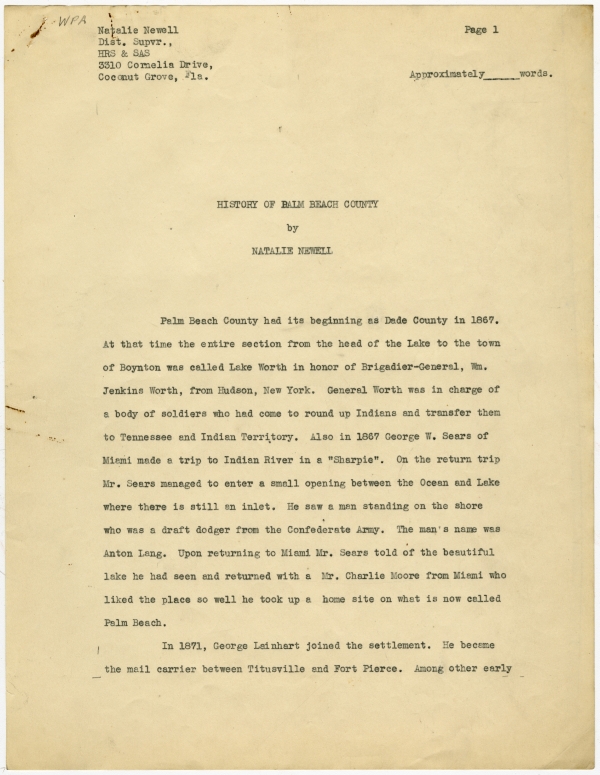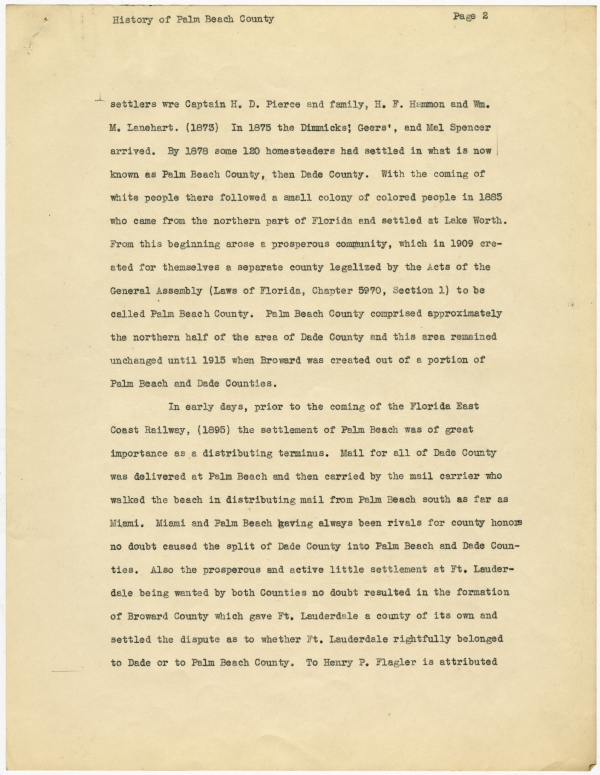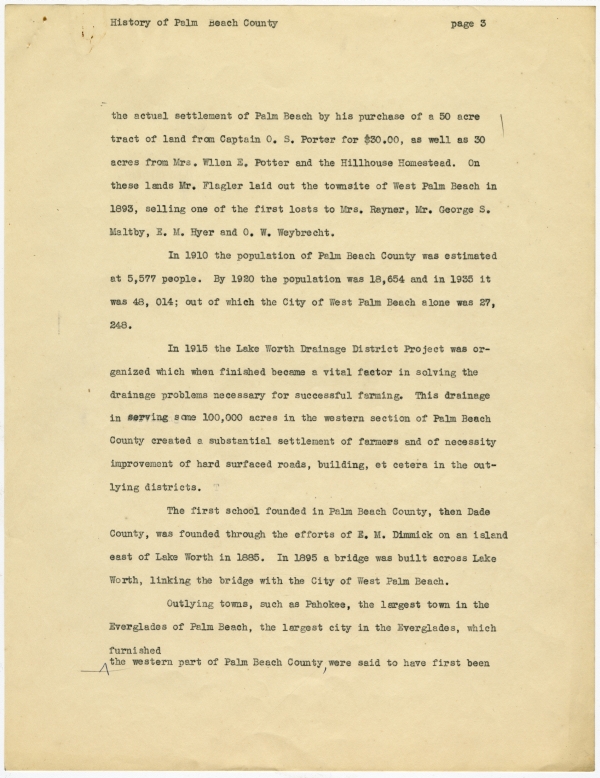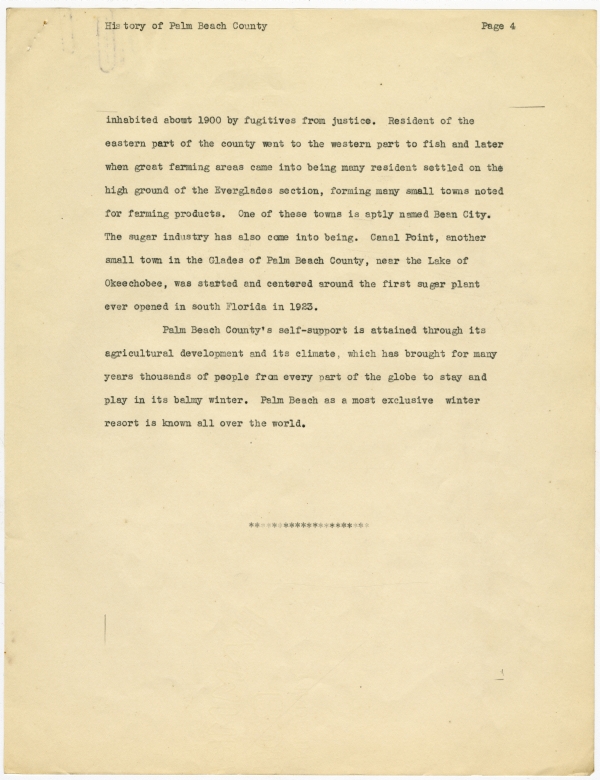WPA
Page 1
Natalie Newell
Dist. Supvr.,
HRS & SAS
3310 Cornelia Drive,
Coconut Grove, Fla.
Approximately_______words.
HISTORY OF PALM BEACH COUNTY
by
NATALIE NEWELL
Palm Beach County had its beginning as Dade County in 1867. At that time the entire section from the head of the Lake to the town of Boynton was called Lake Worth in honor of Brigadier-General, Wm. Jenkins Worth, from Hudson, New York. General Worth was in charge of a body of soldiers who had come to round up Indians and transfer them to Tennessee and Indian Territory. Also in 1867 George W. Sears of Miami made a trip to Indian River in a "Sharpie". On the return trip Mr. Sears managed to enter a small opening between the Ocean and Lake where there is still an inlet. He saw a man standing on the shore who was a draft dodger from the Confederate Army. The man's name was Anton Lang. Upon returning to Miami Mr. Sears told of the beautiful lake he had seen and returned with a Mr. Charlie Moore from Miami who liked the place so well he took up a home site on what in now called Palm Beach.
In 1871, George Lainhart joined the settlement. He became the mail carrier between Titusville and Fort Pierce. Among other early
History of Palm Beach County
Page 2
settlers [were] Captain H. D. Pierce and family, H. F. Hammon and Wm. M. Lanehart. (1873) In 1875 the Dimmicks; Geers', and Mel Spencer arrived. By 1878 some 180 homesteaders had settled in what is now known as Palm Beach County, then Dade County. With the coming of white people there followed a small colony of colored people in 1885 who came from the northern part of Florida and settled at Lake Worth. From this beginning arose a prosperous community, which in 1909 created for themselves a separate county legalized by the Acts of the General Assembly (Laws of Florida, Chapter 5970, Section 1) to be called Palm Beach County. Palm Beach County comprised approximately the northern half of the area of Dade County and this area remained unchanged until 1915 when Broward was created out of a portion of Palm Beach and Dade Counties.
In early days, prior to the coming of the Florida East Coast Railway, (1895) the settlement of Palm Beach was of great importance as a distributing terminus. Mail for all of Dade County was delivered at Palm Beach and then carried by the mail carrier who walked the beach in distributing mail from Palm Beach south as far as Miami. Miami and Palm Beach having always been rivals for county honors no doubt caused the split of Dade County into Palm Beach and Dade Counties. Also the prosperous and active little settlement at Ft. Lauderdale being wanted by both Counties no doubt resulted in the formation of Broward County which gave Ft. Lauderdale a county of its own and settled the dispute as to whether Ft. Lauderdale rightfully belonged to Dade or to Palm Beach County. To Henry P. Flagler is attributed
History of Palm Beach County
Page 3
the actual settlement of Palm Beach by his purchase of a 50 acre tract of land from Captain O. S. Porter for $30.00, as well as 30 acres from Mrs. Wllen [sic] E. Potter and the Hillhouse Homestead. On these lands Mr. Flagler laid out the townsite of West Palm Beach in 1893, selling one of the first [lots] to Mrs. Rayner, Mr. George S. Maltby, E. M. Hyer and O. W. Weybrecht.
In 1910 the population of Palm Beach County was estimated at 5,577 people. By 1920 the population was 18,654 and in 1935 it was 48,014; out of which the City of West Palm Beach alone was 27,248.
In 1915 the Lake Worth Drainage District Project was organized which when finished became a vital factor in solving the drainage problems necessary for successful farming. This drainage in serving some 100,000 acres in the western section of Palm Beach County created a substantial settlment of farmers and of necessity improvement of hard surfaced roads, building, et cetera in the outlying districts.
The first school founded in Palm Beach County, then Dade County, was founded through the efforts of E. M. Dimmick on an island east of Lake Worth in 1885. In 1895 a bridge was built across Lake Worth, linking the bridge with the City of West Palm Beach.
Outlying towns, such as Pahokee, the largest town in the Everglades of Palm Beach, the largest city in the Everglades, which furnished the western part of Palm Beach County, were said to have first been
History of Palm Beach County
Page 4
inhabited about 1900 by fugitives from justice. [Residents] of the eastern part of the county went to the western part to fish and later when great farming areas came into being many [residents] settled on the high ground of the Everglades section, forming many small towns noted for farming products. One of these towns is aptly named Bean City. The sugar industry has also come into being. Canal Point, another small town in the Glades of Palm Beach County, near the Lake of Okeechobee, was started and centered around the first sugar plant ever opened in south Florida in 1923.
Palm Beach County's self-support is attained through its agricultural development and its climate, which has brought for many years thousands of people from every part of the globe to stay and play in its balmy winter. Palm Beach as a most exclusive winter resort is known all over the world.
*********************




 Listen: The Blues Program
Listen: The Blues Program

